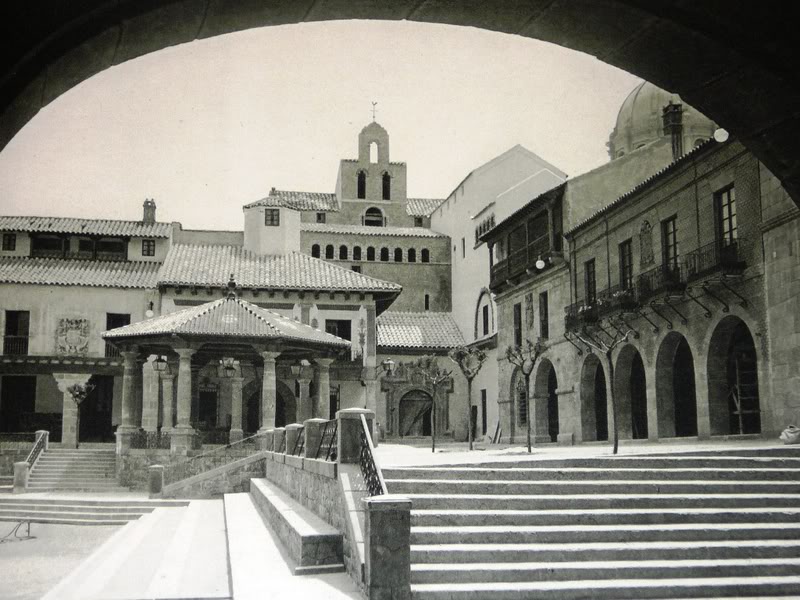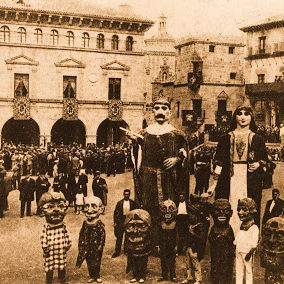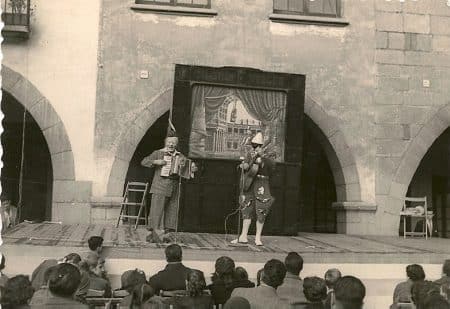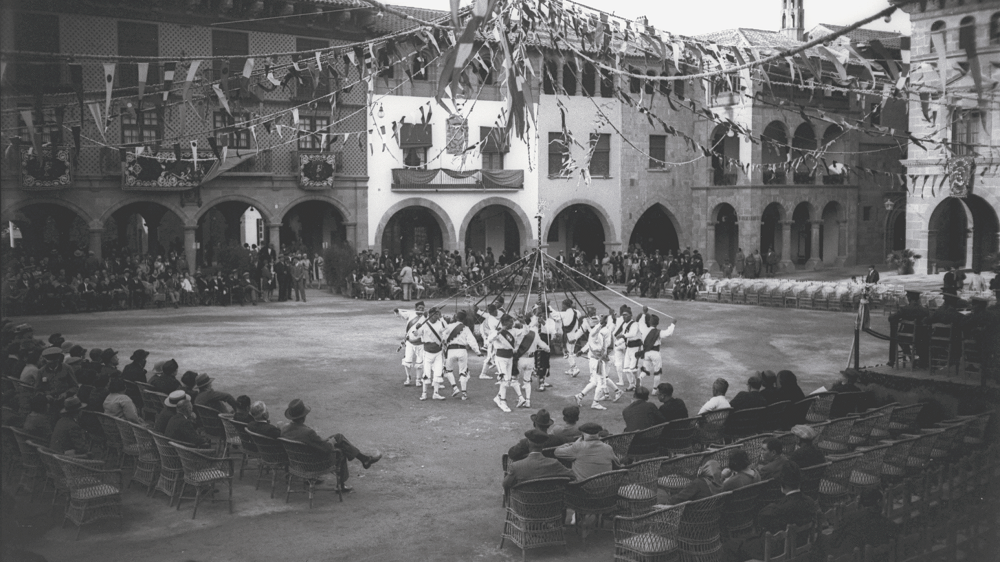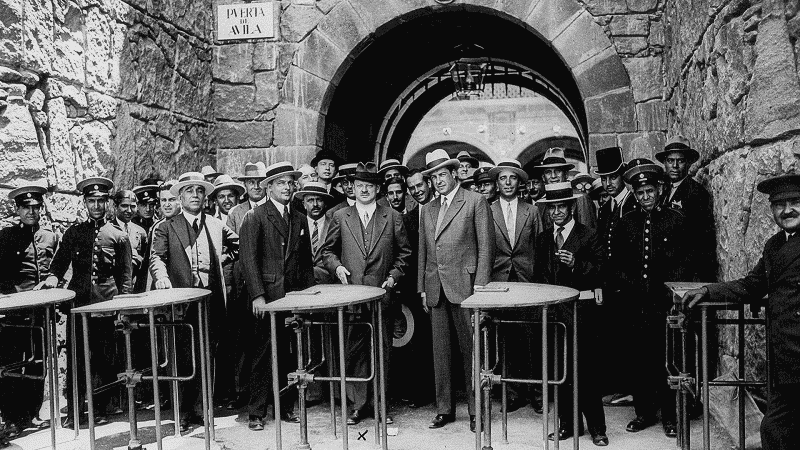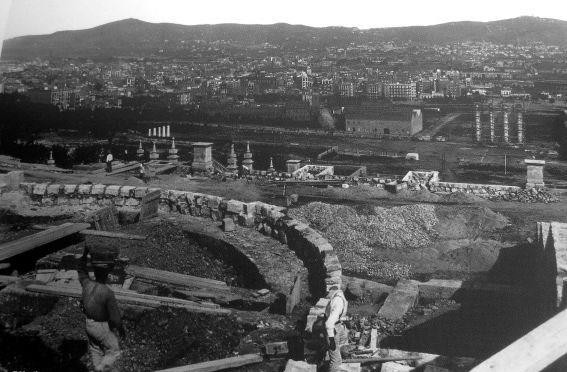AN ICONIC VENUE IN BARCELONA
ESTABLISHED IN 1929
A venue that combined the architectural and cultural essence of Spain so as to impress visitors to the 1929 Barcelona Universal Exposition. Discover the history of Poble Espanyol.
A UNIQUE PROJECT FROM THE VERY BEGINNING
A JOURNEY THAT CHANGED EVERYTHING
The creators of the complex visited more than 1,600 villages before finalising their design. They saw things and collected material which led them to modify fundamental aspects of the project.
Miquel Utrillo, engineer, painter and project leader, Xavier Nogués, draughtsman and painter, Francesc Folguera and Ramón Reventós were tasked with designing a venue that would reflect the most iconic features of traditional Spanish architecture. The initial idea was for it to be demolished at the end of the Universal Exposition, but its creators agreed that it should be conceived of as something that would endure, which turned out to be the case.
Construction work began on the 19th of January 1928 and Poble Espanyol was inaugurated on the 20th of May 1929.
The exhibition entitled “A photographic journey. The construction of Poble Espanyol”, on display in the interior of the complex, will give you an in-depth insight into its origins, inspiration and construction. Don’t miss it!
1929-1930
LEISURE AND CULTURE EACH DAY
The idea was that Poble Espanyol would convey a sense of ongoing public merriment during the Barcelona Universal Exposition. Thus, countless cultural and recreational events were held each day: folk festivals with dances, regional dances, open-air dances, pageants and even horse-riding competitions. This "typical Spanish village" was one of the main attractions of the Exposition. It was such a success that in the end the decision was taken not to demolish it, as had initially been planned.
1939-1950
THE CIVIL WAR AND THE LOSS OF FESTIVE SPIRIT
The festive and convivial spirit associated with Poble Espanyol faded with the outbreak of the Spanish Civil War (1936-1939).
In the darkest episode in its history, the brutal war saw its conversion into a prisoner internment camp.
In the aftermath of the war, the Poble was in danger of falling into ruin. It was then that Barcelona City Council decided to spread the Museum of Popular Arts and Industries over different buildings to prevent it from being destroyed. Meanwhile, Franco’s regime used the museum to disseminate violently anti-Catalanist messages.
FROM THE 60S TO THE 90S
A FAILED ATTEMPT AT REVITALISATION AND THE COMING OF CHANGE
Between 1957 and 1973, Barcelona City Council sought to relaunch the Poble and the hill of Montjuïc as a whole. Despite the refurbishment work and the events that were organised, the venue still failed to function.
By 1986, Catalonia had once more become democratic and autonomous. It was in this context that Barcelona City Council decided to promote Poble Espanyol as “a centre for cultural, leisure and commercial activities and to enhance its appeal as a tourist site and artisanal market”. The time had come for real change, starting with the privatisation of the management of the venue. A project was carried out to restore the original buildings and create a leisure area, a gastronomy area and a service area, as well as significant night-time activities. This relaunch quickly translated into increased numbers: in 1987, 600,000 people visited the Poble and just two years later that figure rose to almost a million. However, despite the positive results in the short term, the Poble continued to accumulate significant losses.
THE RENAISSANCE AND A NEW LOOK TOWARDS THE FUTURE
In order to leave the financial difficulties well and truly behind, a group of businessmen, who could see the venue's potential, decided to take over its management in 1996. It was then that the Poble began to recover.
The venue’s architectural, artisanal and artistic content was developed (in 2001, the Fundación Fran Daurel, an extensive private collection of Spanish contemporary art, was installed) and a regular programme of cultural activities aimed at both local residents and tourists was put in place. In 2016, the venue was further adapted to meet the changing demands of visitors and the times, making use of the latest technologies to increase its cultural content.
In 2020, the venue was dealt a new blow, perhaps the least expected of all. The Covid-19 pandemic forced the Poble to close its doors for three months. This period was used to reassess the objectives and the role of the Poble in the face of this unprecedented situation and confronted with a completely new set of circumstances, full of uncertainty but at the same time, full of hope. On the 11th of June 2020, the venue reopened its doors and established itself as one of the facilities in Barcelona that provides the most activities for local residents. Since that date, the Poble has not stopped working and has embarked on a new course: no longer would it target tourists on the one hand and locals on the other; instead, it would provide cultural and leisure experiences suitable for all audiences in a historic venue, unique in Barcelona.

